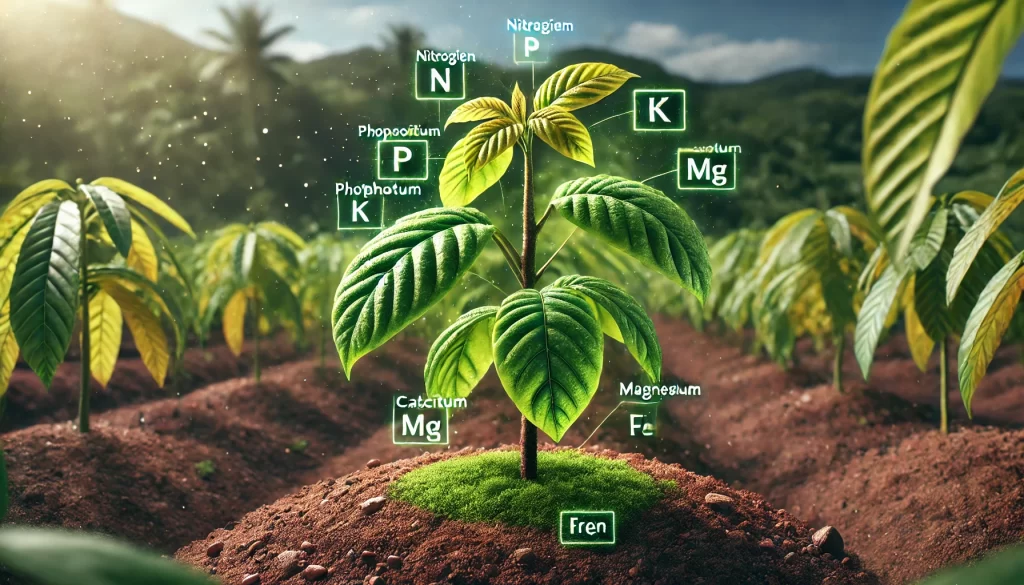Cacao Nutrition
Cacao (Theobroma cacao) is a crop that demands balanced nutrition to achieve optimal growth and high productivity. Proper fertilization management is essential to ensure plant health, maximize the production of quality beans, and maintain long-term soil fertility. Below are the essential aspects of cacao nutrition and best practices for its fertilization.

Nutritional Requirements of Cacao
Essential Nutrients
Cacao, like any crop, requires a specific set of nutrients for its development, which are divided into macronutrients and micronutrients:
- Primary Macronutrients:
- Nitrogen (N): Crucial for vegetative growth, as it is involved in protein and chlorophyll synthesis. Nitrogen is fundamental for leaf formation and root development.
- Phosphorus (P): This nutrient is essential for root development, flowering, and fruit formation. It promotes cellular energy and nutrient transport within the plant.
- Potassium (K): Potassium is key for carbohydrate synthesis and water regulation within the plant. It also increases disease resistance and improves fruit quality.
- Secondary Macronutrients:
- Calcium (Ca): Important for cell wall formation and the structural integrity of the plant.
- Magnesium (Mg): A central component of chlorophyll, it is crucial for photosynthesis.
- Sulfur (S): Involved in the formation of amino acids and proteins.
- Micronutrients:
- Zinc (Zn), Iron (Fe), Copper (Cu), Manganese (Mn), Boron (B), and Molybdenum (Mo) are required in small quantities but are vital for various enzymatic and physiological functions.

Common Nutrient Deficiencies
- Nitrogen Deficiency: Manifests as smaller leaves, pale green or yellowish in color, and overall slow growth.
- Phosphorus Deficiency: Dark green leaves with purple spots and reduced root size.
- Potassium Deficiency: Burned or yellowish leaf edges, and decreased resistance to pests and diseases.
Cacao Fertilization Strategies
Base Fertilization
Before planting, it is crucial to prepare the soil with appropriate base fertilization to ensure an initial supply of nutrients. This fertilization may include:
- Organic Matter: Incorporating compost or well-decomposed manure improves soil structure, increases moisture retention, and provides essential nutrients.
- Natural Phosphates: Applying phosphorus in forms such as rock phosphate is a common practice in phosphorus-deficient soils.

Maintenance Fertilization
Once the plants are established, maintenance fertilization is carried out to meet the ongoing needs of the cacao, particularly during periods of vegetative growth and fruit production.
Nitrogen Fertilization
- Nitrogen: Should be applied in split doses during the growing season to avoid leaching and ensure efficient absorption. Urea or ammonium sulfate is generally used, applied at two or three critical times: at the beginning of the rainy season, during foliar development, and at the onset of fruit formation.
Phosphorus and Potassium Fertilization
- Phosphorus: Generally applied at the start of the rainy season to promote root development. The application of triple superphosphate is common in intensive production systems.
- Potassium: Crucial during the fruiting phase. Potassium chloride or potassium sulfate is applied mid-growing season to ensure good grain quality.

Micronutrients
The application of micronutrients such as zinc, boron, and magnesium may be necessary in poor soils or in cases of deficiencies detected by foliar analysis. These nutrients are usually applied through foliar fertilization to quickly correct deficiencies and improve absorption.
Organic Fertilization and Sustainability
The use of organic fertilizers, such as nutrient-enriched compost or biofertilizers, is an effective strategy to maintain soil health and reduce dependence on chemical fertilizers. Organic fertilization not only provides nutrients but also improves soil structure and promotes a healthy microbiota.
- Compost and Manure: Apply mature compost around the plants at the beginning of the rainy season to improve water retention and nutrient availability.
- Biofertilizers: Use microbial consortia that promote phosphorus solubilization and nitrogen fixation, contributing to more balanced nutrition.

Monitoring and Adjusting Fertilization
Continuous monitoring of the crop’s nutritional status through foliar and soil analysis is essential to adjust the doses and types of fertilizers applied. This approach allows for optimized fertilization, reducing costs and avoiding over-fertilization, which can harm the crop and the environment.
 AgronoBlog – Agriculture Blog
AgronoBlog – Agriculture Blog 


